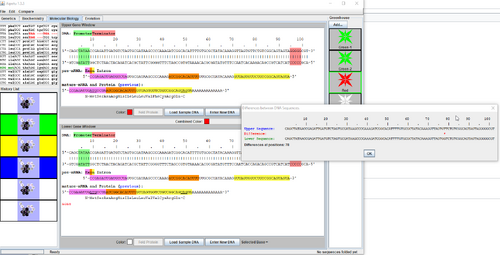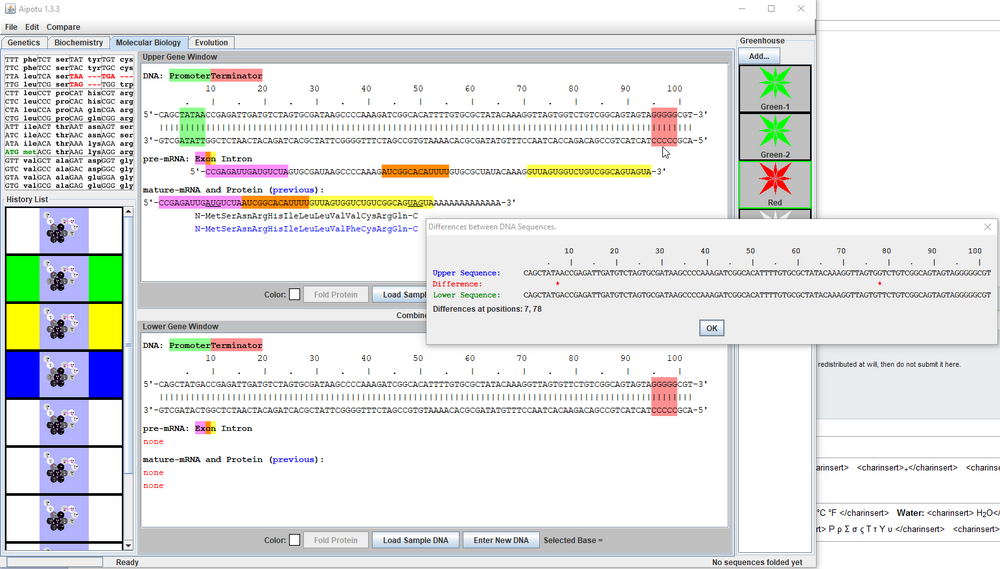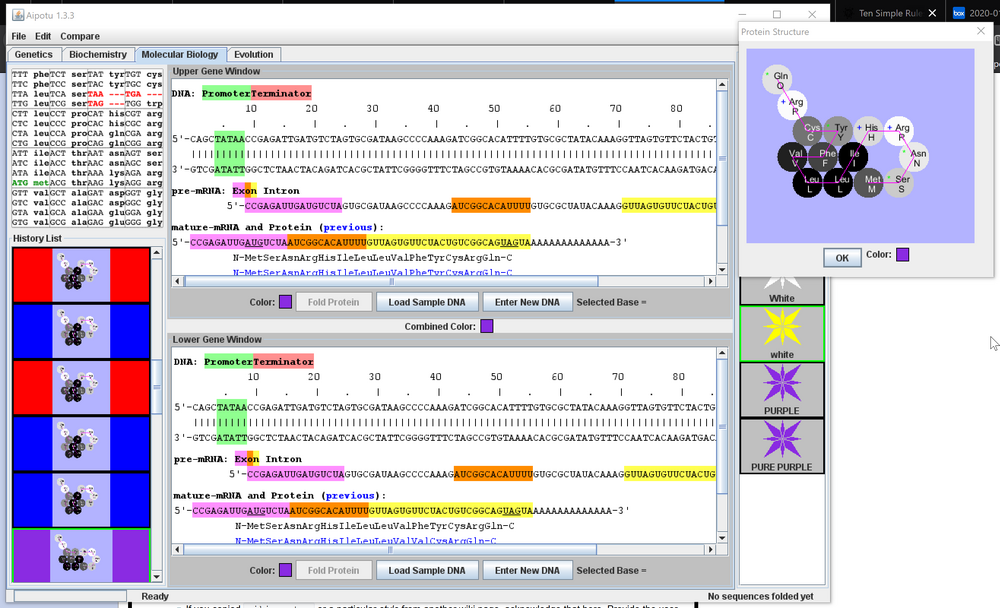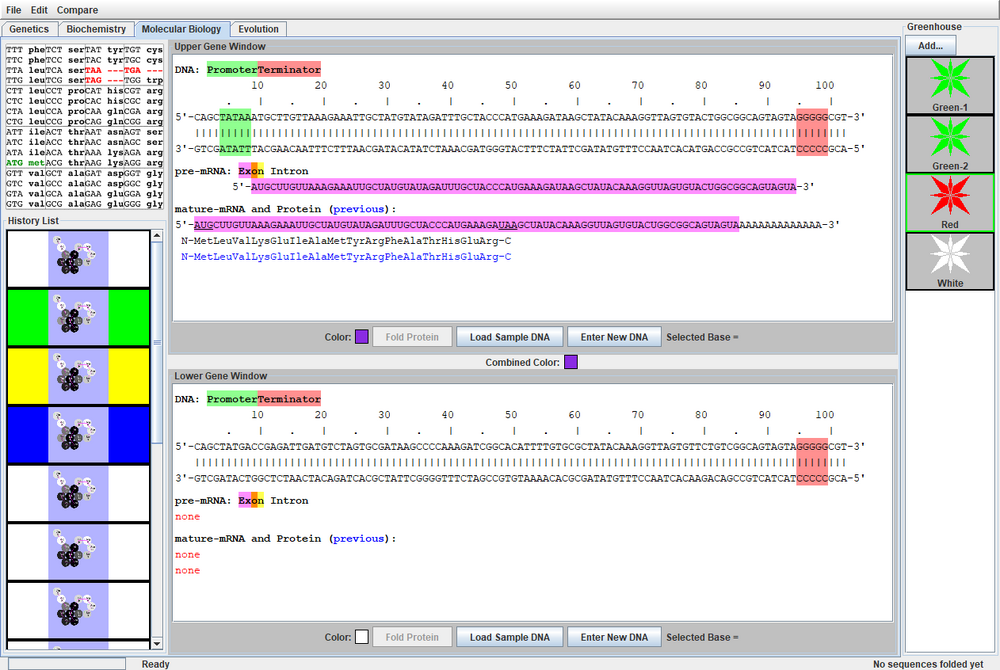Non: Week 2
Purpose
The purpose of today's lab is to analyze differences in DNA to create construct a purple phenotype flower using the Molecular Biology module of Aipotu. By using the molecular biology module, it will combine elements of genetics and biochemistry to solve the problem.
Combined Methods/Results
Protocol
- I downloaded the Aipotu program for this week's lab. Our group specifically only used the 'Molecular Biology' section.
- I familiarized myself with the program's interface using the assigned protocol, primarily pages 4-6.
- I completed the tasks assigned on pages 7-8.
General Notes
Here are my unorganized notes taken with my group during the exercise.
dif b/w green and blue at position 83
yellow and green: 79, 80, 83
blue yellow: 79, 80
red white: 7
red blue: 79
white blue: 78, 79
white yellow: 78, 79 80
red yellow: 79, 80
green red: 79, 83 FORMS BLACK
green white: 7, 79, 83
Purple: changed yellow 79-80 (GG) to (TC)
GREEN DNA SEQUENCE: CAGCTATAACCGAGATTGATGTCTAGTGCGATAAGCCCCAAAGATCGGCACATTTTGTGCGCTATACAAAGGTTAGTGTACTGGCGGCAGTAGTAGGGGGCGT
WHITE DNA: CAGCTATAACCGAGATTGATGTCTAGTGCGATAAGCCCCAAAGATCGGCACATTTTGTGCGCTATACAAAGGTTAGTGGTCTGTCGGCAGTAGTAGGGGGCGT
PURPLE DNA?: CAGCTATAACCGAGATTGATGTCTAGTGCGATAAGCCCCAAAGATCGGCACATTTTGTGCGCTATACAAAGGTTAGTGTTCTACTGTCGGCAGTAGTAGGGGGCGT (added Tyr to blue sequence to form pure purple?)
Questions
a. What are the differences in the DNA sequences of the alleles you defined in Part I?

- With the four given organisms, we identified five main alleles: red, white, blue, green, and yellow.
- We compared differences in the base positions between different alleles as seen above in the general notes. An example of how these differences were found can be seen in the picture to the right. A table of the differences which are shown bolded was generated as below.
| Allele: Color | Changes in Amino Acid Sequence | Changes in DNA Sequence |
| C-w: White | N-MetSerAsnArgHisIleLeuLeuValValCysArgGln-C | CAGCTATAACCGAGATTGATGTCTAGTGCGATAAGCCCCAAAGATCGGCACATTTTGTGCGCTATACAAAGGTTAGTGGTCTGTCGGCAGTAGTAGGGGGCGT |
| C-r: Red | N-MetSerAsnArgHisIleLeuLeuValPheCysArgGln-C (Val -> Phe) | CAGCTATAACCGAGATTGATGTCTAGTGCGATAAGCCCCAAAGATCGGCACATTTTGTGCGCTATACAAAGGTTAGTGTTCTGTCGGCAGTAGTAGGGGGCGT (bp #78) |
| C-g: Green | N-MetSerAsnArgHisIleLeuLeuValTyrTrpArgGln-C (Val -> Tyr, Val -> Trp) | CAGCTATAACCGAGATTGATGTCTAGTGCGATAAGCCCCAAAGATCGGCACATTTTGTGCGCTATACAAAGGTTAGTGTACTGGCGGCAGTAGTAGGGGGCGT (bp #78,79,83) |
| C-y: Yellow | N-MetSerAsnArgHisIleLeuLeuValTrpCysArgGln-C (Val -> Trp) | CAGCTATAACCGAGATTGATGTCTAGTGCGATAAGCCCCAAAGATCGGCACATTTTGTGCGCTATACAAAGGTTAGTGTGGTGTCGGCAGTAGTAGGGGGCGT (bp #78,79,80) |
| C-b: Blue | N-MetSerAsnArgHisIleLeuLeuValTyrCysArgGln-C (Val -> Tyr) | CAGCTATAACCGAGATTGATGTCTAGTGCGATAAGCCCCAAAGATCGGCACATTTTGTGCGCTATACAAAGGTTAGTGTACTGTCGGCAGTAGTAGGGGGCGT (bp #78,79) |
b. Do all the white alleles have the same DNA sequence?
- We found that the white phenotype could be expressed genetically in two ways.
- In the white flower given to use, it had two copies of a white allele that each coded for a white protein.
- In the red flower, it had a copy of a "white" allele (along with the red allele) that did not actually code for a protein, signifying the absence of a pigment.
- As seen in the picture below, a mutation (as seen at base pair position #7 here) other than the ones shown the table above, causes the lack of formation of a protein and thereby produces no pigment, or white.
c. Which DNA sequences are found in each of the four starting organisms?
- Green-1
- allele 1 (green): CAGCTATAACCGAGATTGATGTCTAGTGCGATAAGCCCCAAAGATCGGCACATTTTGTGCGCTATACAAAGGTTAGTGTACTGGCGGCAGTAGTAGGGGGCGT
- allele 2 (green): CAGCTATAACCGAGATTGATGTCTAGTGCGATAAGCCCCAAAGATCGGCACATTTTGTGCGCTATACAAAGGTTAGTGTACTGGCGGCAGTAGTAGGGGGCGT
- Green-2
- allele 1 (blue): CAGCTATAACCGAGATTGATGTCTAGTGCGATAAGCCCCAAAGATCGGCACATTTTGTGCGCTATACAAAGGTTAGTGTACTGTCGGCAGTAGTAGGGGGCGT
- allele 2 (yellow): CAGCTATAACCGAGATTGATGTCTAGTGCGATAAGCCCCAAAGATCGGCACATTTTGTGCGCTATACAAAGGTTAGTGTGGTGTCGGCAGTAGTAGGGGGCGT
- Red
- allele 1 (red): CAGCTATAACCGAGATTGATGTCTAGTGCGATAAGCCCCAAAGATCGGCACATTTTGTGCGCTATACAAAGGTTAGTGTTCTGTCGGCAGTAGTAGGGGGCGT
- allele 2 ("white"): CAGCTATGACCGAGATTGATGTCTAGTGCGATAAGCCCCAAAGATCGGCACATTTTGTGCGCTATACAAAGGTTAGTGTTCTGTCGGCAGTAGTAGGGGGCGT
- White
- allele 1 (white): CAGCTATAACCGAGATTGATGTCTAGTGCGATAAGCCCCAAAGATCGGCACATTTTGTGCGCTATACAAAGGTTAGTGGTCTGTCGGCAGTAGTAGGGGGCGT
- allele 2 (white): CAGCTATAACCGAGATTGATGTCTAGTGCGATAAGCCCCAAAGATCGGCACATTTTGTGCGCTATACAAAGGTTAGTGGTCTGTCGGCAGTAGTAGGGGGCGT
d. Using this knowledge, construct a pure-breeding purple organism.
- We knew that a flower with a blue and red allele would produce a purple flower. However, this flower would not be pure breeding as some of its offspring would be red and blue. To create a pure-breeding purple flower, we would need to find a purple allele.
- Our group: Madeleine, Karina and I hypothesized if we could combine the unique mutations from the blue allele and the red allele, we would create a purple allele.
- Unbeknownst to me at the time, this was actually hinted at in the two green flowers. Green-1 features the combination of unique amino acids in the blue allele (Tyr) and the red allele (Trp) to create a pure green protein.
- Therefore to create a purple allele, I simply added the unique blue amino acid Tyr to the amino acid sequence of the red allele, right after the unique red amino acid Phe. This can be seen in the picture below.
- We also found that the reverse order (Tyr, Phe) also created a purple flower
e. How does the DNA sequence of the different alleles explain the effects of mutations you found in part I?
- The DNA sequence helps to understand how these mutations arose. The differences between two alleles often only consisted of 2-3 base pair changes which produced dramatically different colors as result of the change in amino acids.
f. Try making this protein: MLVKEIAMYRFATHER
- This exercise simply involved converting the amino acid single letter code to codons. The result is shown below.
Scientific Conclusion
This exercise was culmination of work in classical genetics and biochemistry. By visualizing the changes in colors with combining different alleles as Mendel did, with studying biochemistry and the effects of mutations on the DNA sequence, we were able to create a pure-breeding purple flower by predicting and following the pattern of alleles. The combination of the blue allele with the unique amino acid of the red allele produced a purple flower.
Data and Files
Pictures Generated
Acknowledgements
- I worked with Madeleine King and Karina Vescio as my group partners for this project, where we worked together in figuring out and answering all of the questions above.
- I used the Aipotu Program and Molecular Biology Protocol to complete this exercise.
- I used and modified the Week 2 Protocol as a framework for this exercise.
- I looked at my user page as a refresher for table, picture and list syntax.
- "Except for what is noted above, this individual journal entry was completed by me and not copied from another source."
Non (talk) 19:34, 29 January 2020 (PST)
References
- OpenWetWare. (2020). BIOL368/S20:Week 2. Retrieved January 29, 2020, from https://openwetware.org/wiki/BIOL368/S20:Week_2
- Aipotu 1.3.3. (2017). Aipotu. Retrieved January 29, 2020, from http://aipotu.umb.edu/
- Aipotu Part III: Molecular Biology. (2017). Aipotu. Retrieved January 29, 2020, from http://aipotu.umb.edu/docs/AipotuIII.pdf


